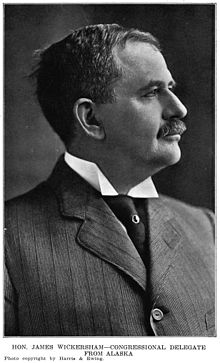James Wickersham
| James Wickersham | |
|---|---|
 |
|
| Territorial Delegate to the U.S. House of Representatives from Alaska | |
|
In office March 4, 1931 – March 3, 1933 |
|
| Preceded by | Daniel Sutherland |
| Succeeded by | Anthony Dimond |
|
In office March 1, 1921 – March 3, 1921 |
|
| Preceded by | George Barnes Grigsby |
| Succeeded by | Daniel Sutherland |
|
In office January 7, 1919 – March 3, 1919 |
|
| Preceded by | Charles August Sulzer |
| Succeeded by | Charles August Sulzer |
|
In office March 4, 1909 – March 3, 1917 |
|
| Preceded by | Thomas Cale |
| Succeeded by | Charles August Sulzer |
| Personal details | |
| Born |
August 24, 1857 Patoka, Illinois, U.S. |
| Died | October 24, 1939 (aged 82) Juneau, Alaska Territory, U.S. |
| Political party | Republican |
| Spouse(s) | Deborah |
| Profession | judge, politician |
 |
| History of Alaska |
|---|
| Prehistory |
| Russian America (1733–1867) |
| Department of Alaska (1867–1884) |
| District of Alaska (1884–1912) |
| Territory of Alaska (1912–1959) |
| State of Alaska (1959–present) |
| Other topics |
James Wickersham (August 24, 1857 – October 24, 1939) was a district judge for Alaska, appointed by U.S. President William McKinley to the Third Judicial District in 1900. He resigned his post in 1908 and was subsequently elected as Alaska's delegate to Congress, serving until 1917 and then being re-elected in 1930. He was instrumental in the passage of the Organic Act of 1912, which granted Alaska territorial status, introduced the Alaska Railroad Bill, legislation to establish McKinley Park, and the first Alaska Statehood Bill in 1916. He was among those responsible for the creation of the Alaska Agricultural College and School of Mines, which later became the University of Alaska. A residence hall on the University of Alaska Fairbanks campus is named in his honor.
Wickersham was born near Patoka, Illinois and moved in 1883 with his wife, Deborah, to Tacoma, Washington Territory, where he became a judge. While in Tacoma he helped lead a mob which forced the city's Chinese population out of town, and was later arrested as one of the "Tacoma Twenty-Seven," though he was never convicted. He was a member of the Tacoma Academy of Science and was President of that organization in 1893. He presented a paper to the Academy on 6 Feb, 1893, entitled, Is it Mount Tacoma, or Rainier? During the presentation the "following prominent Indians representing the Puyallup, Nesqually and Klickitat tribes were seated on the platform: George Leschi, son of Quiemuth, a leader in the Indian war of 1855; Jack Simmons; John Hiaton, one of the patriarchs of the reservation, 80 years of age, and a signer of the treaty of 1854; Mrs. John Hiaton and John Powers". The presentation has been reproduced by a digital file created at the Library of Congress.
When Wickersham set off for Alaska he was allegedly dodging a government posting in Japan, and he told anyone who asked that he preferred the Eagle post, saying he “yearned for the Yukon, not Yokohama”. With the introduction of federal oversight in the form of three district court judges, Wickersham being one of the two new appointees, his peers being Arthur Noyes in Nome and previously established Melville C Brown in Juneau, he was now one of the three most powerful people in Alaska, with no one within 3,000 miles to overrule his decisions or stand in his way. After the Nome Gold Conspiracy involving prominent Republican National Committee member Alexander McKenzie, it was Wickersham they turned to clean up the legal mess left by then ousted Judge Noyes, allegedly involved. Through his hard work, and his tenacity, he made sure everyone understood his authority. His start into Alaskan official law was a litigation of most profound simplicity, and the epitome of Alaskan frontier spirit. “Chief Charley, head of the Charley River band of the Tena Indians, was the first litigant to appeal to the new court officials for justice.” Someone from upriver had stolen his dog, a very serious offense that warranted violence if this new American law official could not have it solved within his power peacefully. After being given the run around, Charley finally reached Wickersham and consulted the highest court in the land. After listening carefully Wickersham appointed a deputy to retrieve the stolen animal, and waited with the chief for his return, chatting about everyday problems. When the dog was safely returned two points were driven home, the concrete authority of Judge Wickersham, and that his tenure in Alaska would be one of action. As the most powerful personage of Federal oversight for the vast majority of the interior of Alaska, Wickersham was an important man to have on your side. His relationship with the development of Fairbanks helped shape not only the future of the Interior’s steadily expanding city, but also the shape of things to come for the state. Wickersham’s working relationship with Captain ET. Barnette led to the initially small settlement developing into a city that became a gateway to the arctic. Through Barnette and Wickersham’s efforts, Fairbanks became incorporated, initiated federal development, and settled locations for key federal positions in the city thus insuring its future relevance.
...
Wikipedia
